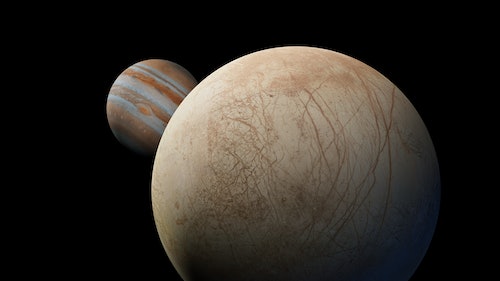Europa and other ocean worlds in our solar system have recently attracted much attention. and other ocean worlds in our Solar System have recently attracted much attention. They are thought to be some of the most likely places in our Solar System for life to have developed off Earth, given the presence of liquid water under their ice sheathes and our understanding of liquid water as one of the necessities for the development of life.
Various missions are planned for these ocean worlds, but many suffer from numerous design constraints. Requirements to break through kilometers of ice on a world far from the Sun will do that to any mission. These design constraints sometimes make it difficult for the missions to achieve one of their most important functions — the search for life.
But a team of engineers from NASA’s Jet Propulsion Laboratory think they have a solution — send forth a swarm of swimming microbots to scour the ocean beneath a main “mothership” bot. One of the most likely forms of the mothership bot for this mission is the Subsurface Access Mechanism for Europa — SESAME. It’s a type of “thermo-mechanical drilling robot” that can tunnel through Europa’s thick ice shell, which measures up to 25 km in some places.
It does this by melting, cutting, and burning straight down to reach the interface between Europa’s ice crust and its undersea ocean. But what happens once the drilling bot gets there? Ideally, the robot itself would explore its immediate surroundings. However, there is a good chance that drilling through the ice crust (thereby disrupting the nearby environment) will limit the usefulness of any data collected nearby.
The bot itself could go for a dip, but the power source required to drill through all that ice would likely create a “hot bubble” around the robot, diminishing the usefulness of any science its sensors attempt to do. Dr. Ethan Scahler, a mechanical engineer at NASA’s JPL who had two separate NIAC grants in 2021, explains SWIM and FLOAT – his two awarded concepts.
That’s where the Sensing with Independent Microswimmers (SWIM) idea comes in. SWIM bots could deploy from the SESAME bot after it breaches into the ocean from the ice shelf. Once deposited into the water, they can move away autonomously from the mothership and explore distances up to a few hundred meters away.
Doing so with a tether is tricky. If there is more than one microbot nearby, it’s very likely the tether would become ensnared, and mission engineers would end up trying to untie a Gordian knot in another world. Alternatively, not using a tether has its own set of challenges.
One is communication. Water is notoriously difficult to transfer electric signals through. Hence, the JPL engineers suggested using an ultrasonic communication system to send data from the mothership to the microbots and vice versa.
Potentially, the SESAME mothership could also power the microbots using an underwater power transfer technique, though there are a lot of ways that can go wrong. Fraser discusses a more recent NIAC grant to cut through the ice on the way down to Europa’s ocean. An alternative is to develop a sound enough control system so the bots can return to the mothership to recharge before going out on another mission into the depths.
Some of the most exciting environments in the solar system are out in those depths. In recent decades, scientists have discovered whole ecosystems on Earth that live entirely separately from the Sun by utilizing energy emitted from thermal vents. There is a good chance the Enceladus also has thermal vents in its oceans and a decent chance that the microswimmers can get to them to collect data.
While their instrumentation might not be all that capable, especially compared to a larger, single submersible, having many microbots would allow them to spread out. That dramatically increases their chances of coming across one of these underwater vents, if they exist, increasing their chance of finding life on one of these ocean worlds. That’s still a long way off, though NASA seems supportive of the idea — they granted the team at JPL a NIAC Phase II grant to further flesh out the concept.
Hopefully, that’ll provide enough background research to push this idea into a viable state for full-blown mission development. Maybe someday we’ll be able to watch as little microbots explore the ocean of a completely different world. .
From: inverse
URL: https://www.inverse.com/science/a-swarm-of-swimming-microbots-could-be-deployed-to-europas-ocean



